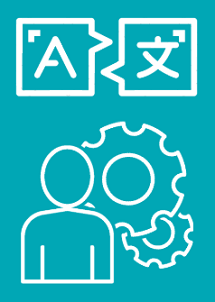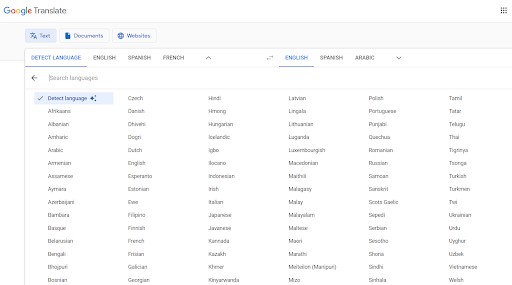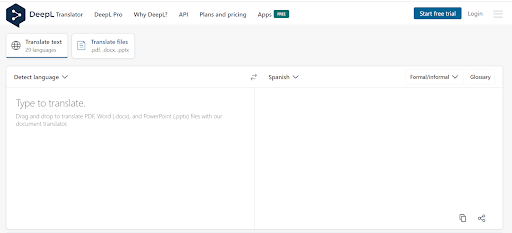What is machine translation and how it works
The history of machine translation goes back to the 1930s, but it is now with the development of neural machine translation and artificial intelligence that machine translation has become a common tool for both professional and personal use.
Some people say it will soon replace human translators, while others say it still creates embarrassing mistranslations and it may damage your business’ reputation. So which of these statements is closer to the truth? As a business owner, should you use machine translation services? Which are the main benefits?
In this blog post, we uncover the most common questions about machine translation and whether you should use it to communicate with your global audience.

What is machine translation?
Machine Translation (MT) is a technology that helps process an original text in a given language — what we call source language — to produce a translated version — into what we call a target language.
MT works using a combination of language rules (syntax, grammar), statistical data (i.e., which words tend to be found near other words), and a text corpus made up of millions of words from real documents and files that are used by the MT engine to check and predict the best possible match for each sentence.
3 types of machine translation
These are the three most common types of machine translation:
Rule-Based Machine Translation (RBMT)
RBMT systems rely on grammatical and syntactical rules developed by language experts to understand the relationship between two languages. RBMT analyses the words and the meanings they can have depending on a given context. This technology is usually associated with the creation of MT solutions that are specific to certain fields such as engineering or medicine.
Statistical Machine Translation (SMT)
SMT does not rely on linguistic rules and words, but it generates translations by analysing previously translated bilingual texts. This technology is able to identify relationships between words and sentences in bilingual text corpora and generates statistical models that are used to decide the most likely translation.
Neural Machine Translation (NMT)
Neural Machine Translation uses artificial intelligence and neural network techniques to learn languages and predict the likelihood of a set of words appearing in sequence. NMT systems generally produce higher-quality translations than RBMT and SMT.
Which machine translation tool should I use?
The latest machine translation technology (such as DeepL) uses NMT as the methodology to translate. Let’s have a closer look at two of the most popular machine translation tools in the market.
Google Translate
Launched in 2006, Google Translate has reached high-quality levels not only for the most common language pairs but also for less popular ones. But this was not always the case. In November 2016, Google announced that Google Translate would switch from a statistical-based to neural machine translation, and it was this new technology that allowed them to reach much better results.
The free version of Google Translate currently lets you translate texts in 133 languages, translating your entire documents with copy and paste. The paid version has more features, such as creating user-defined translation models that allow you to train the machine translation engine with your own bilingual data.

DeepL
The German MT tool DeepL was launched in 2017 and it currently works in over 700 possible combinations between 27 languages.
The machine translation software learns using models from Linguee (the world’s biggest database of human translations) and the results are similar to, or even better, than Google Translate for some languages.
The paid version has very useful features such as creating glossaries to use the right terminology and ensure consistency, or the option to use the formal or informal tone for some languages including Dutch, French, German, Italian, Polish and Spanish. It also offers a CAT tool integration as well as end-to-end encryption of the translated data, so your information can not be accessed by a third party.

When should I use machine translation?
Theoretically, MT can be used in any kind of text, provided that the source material is correctly written and has a clear structure and no major mistakes that may prevent the machine -and any reader- from understanding the content. However, the nature of your business determines the style and tone of voice used in your blog posts, user manuals, newsletters and other materials. Using the “same” machine translation software for different types of texts and industries certainly has limitations.
There are some industries where MT works better thanks to documents featuring a more straightforward layout that helps a machine read the information more efficiently. Technical documentation, user guides with large parts of predictable text structures and medical reports usually work better for MT. Nevertheless, the scope of MT is becoming wider every day, and it can be applied to media or legal translations with an increasing degree of accuracy.
If you are not sure about whether MT can be used to translate your documents, the team at Ampere Translation will be pleased to help you. Get in touch!
What is Machine Translation Post-Editing (MTPE)?
The MT engine has already pre-processed your documents, creating a set of translated files that are ready to be used! Well, not quite.
MT does a pretty decent job processing many types of text, preferably using not-too-complex sentence structures and a straightforward style. However, remember that MT does NOT understand the text: it simply processes words following a complex pattern, but cannot decide whether a word with several possible interpretations has been used with a specific intention. Only human translators can understand those nuances and make an educated decision about the best fit for each translated word.
Machine translation post-editing (MTPE) is the process where a text previously translated by an MT engine is edited by a human translator to ensure there are no mistakes.
Leaving machine-translated text untouched leads to funny mistranslations in the best case, but it might also lead to catastrophic errors (imagine what can happen if a legally binding term is mistranslated in a contract, or in a manufacturing scheme for aeronautical devices). The human step is essential to guarantee the quality AND safety of the MT output.
Machine translation vs. human translation
Back in the early ’90s, there were already some authoritative voices stating that MT was this close to achieving technical perfection (the long-sought FAHQMT, that is, fully-automated, human-quality machine translation).
Since then, many other voices have been sharing and shouting the same apocalyptic prediction relentlessly. However, human translation is still here, and it is meant to stay. Why?
Leave aside the technicalities of the process behind MT learning, which leads to consistently improved versions of this technology. No matter how refined the tech becomes, there are several inherent aspects of communication that no machine can fully understand: intention, style and communicative context. Failing to reproduce them inevitably results in hollow or plainly wrong translations.
In order to ensure that these ingredients are properly added to the translated text, a human touch is required. You might argue that there are currently AI solutions used in several industries that can produce (create!) automated texts for a number of purposes. Of course, this kind of robotic output is the perfect candidate for raw MT: however, the quality requirements are completely different for this type of information than for text that is meant to stay around for a long time or is targeted at your audience.
What are the advantages of machine translation?
Reduced costs
MT can reduce costs remarkably, and you can even translate a text for free. But even when human translators are post-editing the translation, the costs are still much lower because the language specialists do not have to do the translation from scratch but use the machine-translated version as a “draft” that they can refine.
Speed and volume
Money is often considered the most important reason for using machine translation. But the speed and volume that MT can deliver are key, in particular, if there are time constraints.
MT allows the translation of high-volume projects at speed, that then can be edited by translators.
Large language selection
With up to 133 languages and almost countless possible language combinations, Google Translate and other MT engines can simplify product rollouts and updates of content or documentation from a single place.
If your company creates large pieces of information that need to be translated into different languages, MT can help speed up the process and provide a draft version of your texts.
Costantino Pala, Operations Manager at Ampere Translations
Let us guide you through your (machine) translation journey
If quality is what your business stands for, then human translation —perhaps combined with machine translation as we’ve explored in this post— is your best choice. Get in touch today and we’ll find the solution that best suits your needs.
